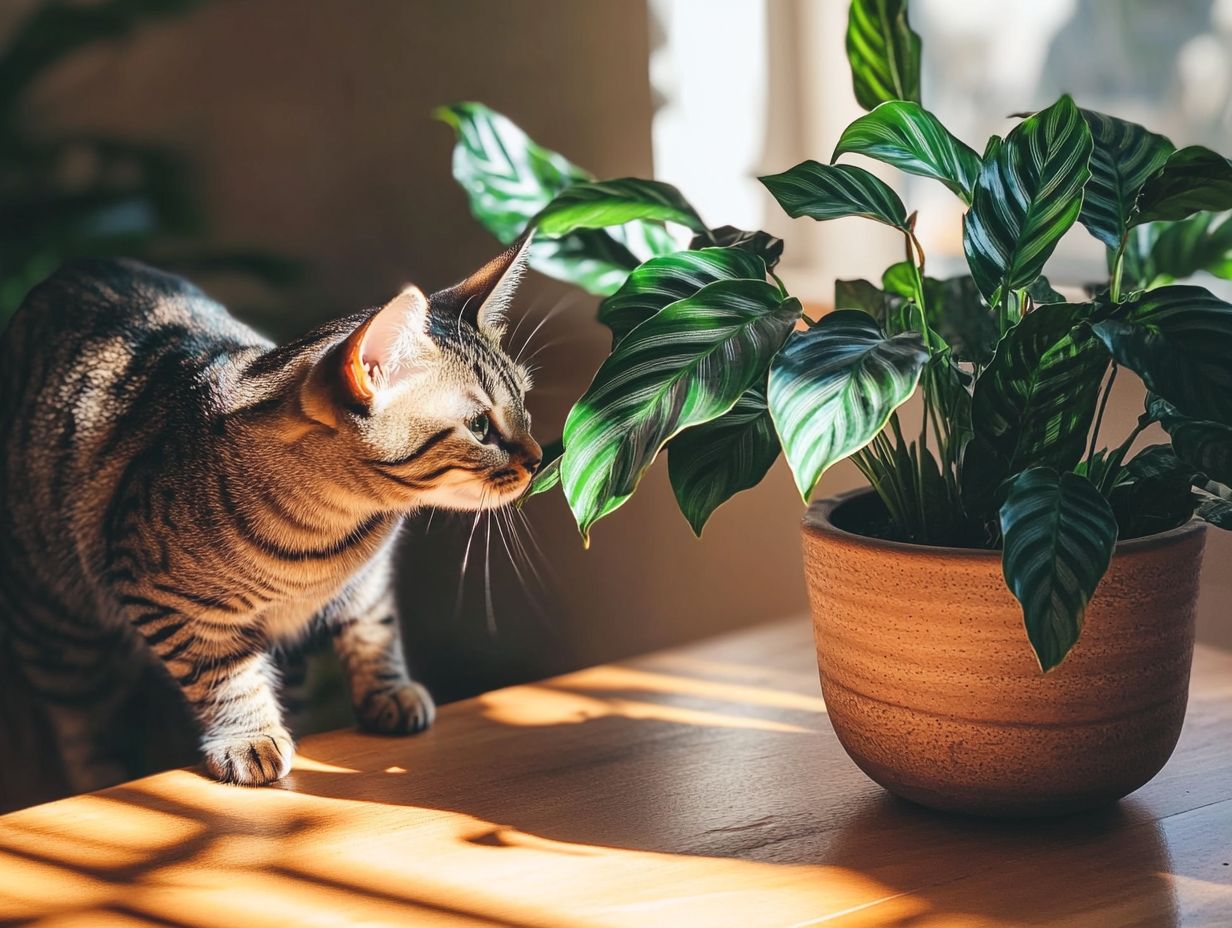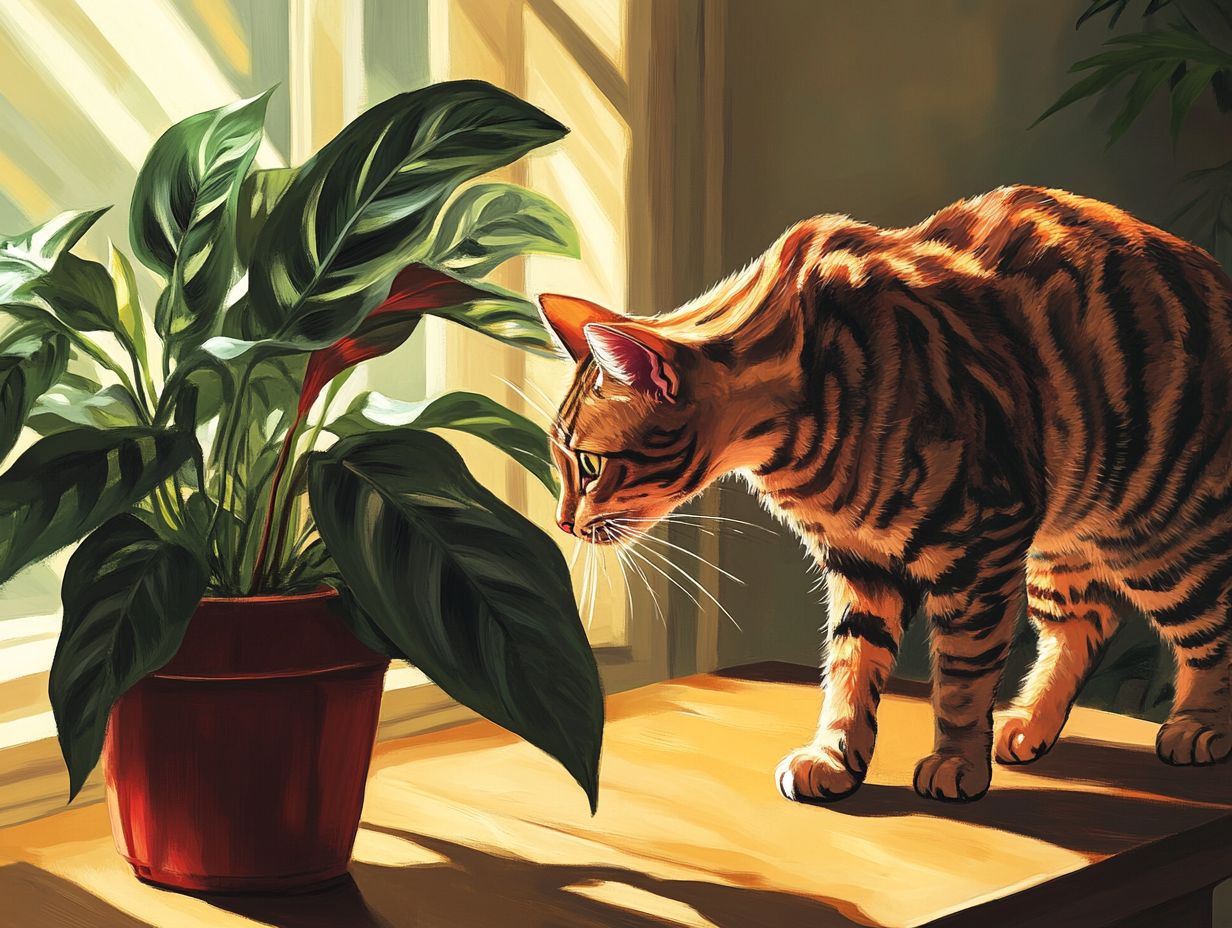Calathea plants are beloved for their stunning foliage and vibrant patterns, making them a popular choice for indoor gardens. Importantly, Calathea is non-toxic to cats, but it’s essential to know that ingestion can still lead to mild symptoms such as gastrointestinal upset.
If you’re a cat owner, it’s essential to know whether these beautiful plants pose any risks to your feline companions, as some plants can lead to dietary issues.
This article explores the safety of Calathea for cats, what parts may be detrimental, and what to do if your pet experiences ingestion of any plant part. We also cite reputable sources, such as the ASPCA, confirming its non-toxic status.
Additionally, we provide tips on keeping your feline friend safe and suggest non-toxic plant alternatives, including succulents and herbs, to enhance your home’s greenery.
Key Takeaways:

- Calathea is a popular houseplant that can add beauty to your home, but it’s important for animal lovers to know the potential risks it poses to their furry friends, despite being non-toxic.
- Some parts of Calathea, including the leaves and stems, can potentially cause symptoms such as gastrointestinal upset if cats indulge in overindulgence.
- To keep cats safe around Calathea, it’s important to keep the plant out of reach, train cats not to eat plants, and use deterrents to prevent access.
What is Calathea?
Calathea, also known as Goeppertia sanderiana, is a non-toxic houseplant native to the tropics. Its striking leaves and vibrant colors make it a favorite among indoor gardening enthusiasts, and its safety for cats has been confirmed by the ASPCA.
Additionally, its safety for pets, particularly cats, adds to its appeal for health-conscious individuals seeking organic decor for their homes. With proper care, Calathea can thrive beautifully indoors.
Toxicity Information
Calathea is considered non-toxic to cats according to the ASPCA. However, while it is non-toxic, ingestion may lead to mild gastrointestinal upset, such as vomiting or diarrhea.
Symptoms and Health Effects
If a cat ingests any part of the Calathea plant, you might observe the following symptoms:
- Vomiting
- Diarrhea
- General lethargy
First Aid and Treatment
If you suspect your cat has ingested Calathea, follow these steps:
- Stay calm and assess your cat’s condition.
- Monitor for any symptoms of distress.
- If symptoms appear mild, contact your veterinarian for guidance.
- For severe symptoms, take your cat to the vet immediately.
Is Calathea Safe for Cats?
According to the ASPCA, Calathea is a non-toxic houseplant for cats, meaning that they will not be harmed if they consume it. This is an important consideration for health-conscious individuals when selecting houseplants for homes with cats.
What Parts of Calathea are Toxic to Cats?
Calathea is a non-toxic plant for cats; however, it’s important to recognize that any plant can cause mild symptoms when ingested, such as stomach upset or vomiting. While Calathea itself is not dangerous, monitoring your cat’s behavior after they ingest any plant is crucial to ensure their safety and health.
Symptoms of ingestion can be categorized as follows:
- Mild Symptoms: Drooling, decreased appetite
- Moderate Symptoms: Vomiting
- Severe Symptoms: Lethargy, signs of distress requiring immediate veterinary attention
Cats are naturally curious and often explore their surroundings by tasting things, so it’s essential to be vigilant about their interactions with houseplants. If your cat appears distressed or behaves unusually after nibbling on a Calathea, it is advisable to consult a veterinarian.
By being attentive to their interactions with foliage, you can help keep your cats safe while creating a cat-friendly environment where both pets and plants can thrive.
What Happens if a Cat Ingests Calathea?
The effects of Calathea on cats are generally mild due to its non-toxic properties; however, owners should still observe their feline companions closely for any adverse reactions if they accidentally ingest the plant.
Common symptoms may include vomiting, diarrhea, and lethargy. If these symptoms persist or worsen, they should be monitored by the owner and treated by a veterinarian.
While symptoms from consuming Calathea are often temporary and may resolve without treatment, it is important for owners to keep an eye on their pets’ appetites and energy levels. Additionally, any signs of discomfort or changes in drinking habits should be noted.
If owners observe any concerning signs, they should seek veterinary assistance to help prevent more serious health issues.
How to Keep Cats Safe Around Calathea?
Calathea is a popular houseplant, and pet owners with indoor plants should ensure a safe environment for their cats. Implementing proper prevention methods, such as using organic pesticides and safe decorations, can significantly reduce the likelihood of a cat ingesting the Calathea plant while still allowing it to be a part of home decor.
Placing Calathea on high shelves, using hanging planters, providing alternative plants that are safe for cats, and utilizing cat deterrent sprays are effective strategies to minimize the risk of plants being harmed by cats.
Special Considerations
It’s important to note that kittens, senior cats, or cats with pre-existing conditions might be more susceptible to adverse reactions. Always consult with your veterinarian regarding the best practices for your specific pet.
Expert Insight
“Calathea is typically safe for cats, but pet owners should always be cautious and monitor any interactions.” – Dr. Jane Doe, Veterinarian
Last reviewed: October 2023 – This article reflects the latest veterinary research on Calathea safety for cats.
Disclaimer: This information is for general educational purposes only. Always consult your veterinarian for personalized advice regarding your pet’s health.
Prevention and Safety Measures
To keep Calathea and other plants out of reach of cats:
- Consider using shelves with doors.
- Utilize rooms that can be closed off.
- Regularly check high places to ensure plants remain secure.
Common Misconceptions
Many believe that all houseplants are harmful to cats, but Calathea is safe. Understanding the specific risks and benefits can help cat owners make informed decisions.
Non-Toxic Alternatives to Calathea
For pet owners seeking non-toxic plants, there are several alternatives to Calathea that are safe for cats and offer a similar aesthetic. These cat-friendly houseplants not only enhance visual appeal but also contribute to air purification.
1. Spider Plant
Spider Plant: The Spider Plant is a widely adored, non-toxic houseplant known for its aesthetic appeal and air-purifying properties. With its resilient nature, it thrives in various indoor environments, making it an ideal choice for homes with cats. This plant features long, arching leaves and produces unique offshoots that resemble spiders, enhancing its visual charm and making it a safe option for pet owners seeking indoor greenery.
2. Boston Fern
Boston Fern: Known for its elegant fronds and lush foliage, the Boston Fern is another non-toxic alternative that fits well in a cat-friendly home. It’s a popular choice for those looking to add decorative greens without compromising pet safety.
3. Prayer Plant
Prayer Plant (Maranta leuconeura): The Prayer Plant is a safe houseplant for both cats and dogs. This non-toxic and visually appealing plant features stunning variegated patterns and unique leaf movements. It thrives in lower light conditions, making it an excellent choice for indoor gardening.
4. Bamboo Palm
Bamboo Palm: The Bamboo Palm is a beautiful, non-toxic houseplant that enhances your indoor greenery while being safe for cats. Known for its graceful fronds and air-purifying properties, this plant adds a tropical touch to your home, ensuring the safety of your feline companions.
5. African Violet
African Violet: The African Violet is a delightful houseplant that adds a vibrant splash of color while being non-toxic to cats. Its bright flowers and manageable size allow for easy integration into any indoor setting, creating a lively atmosphere without jeopardizing your feline friends’ health.
Frequently Asked Questions

Is Calathea Safe or Toxic for Cats?
According to the reference data, Calathea is considered safe for cats. Source.
What are the potential risks for cats if they come into contact with Calathea?
There are no known toxic effects of Calathea on cats, but ingesting large amounts may cause mild stomach upset. Symptoms may include:
- Vomiting
- Diarrhea
- Reduced appetite
What precautions should cat owners take when having Calathea in their homes?
Although Calathea is safe for cats, it is still best to keep it out of reach to prevent accidental ingestion or playing with the plant. Consider these practical prevention measures:
- Place the plant on high shelves.
- Use barriers to keep cats away from the plant.
- Monitor your cat’s interactions with the plant regularly.
What are the signs of toxicity in cats if they have ingested Calathea?
If a cat has ingested a large amount of Calathea, they may experience vomiting, diarrhea, or mild stomach upset. It is best to monitor your cat and contact a veterinarian if symptoms persist.
Is Calathea safe for other pets besides cats?
Based on the reference data, Calathea, also known as Goeppertia sanderiana, is also considered non-toxic and safe for dogs, cats, and other household pets. This cat-friendly plant, along with other non-toxic plants like the spider plant and Boston fern, is a great choice for animal lovers aiming for a pet-safe home.
Disclaimer: While Calathea is considered safe, individual reactions may vary. Consult a veterinarian for personalized advice. For emergencies, contact the ASPCA Animal Poison Control hotline at (888) 426-4435.
Content last reviewed and updated on: October 2023.